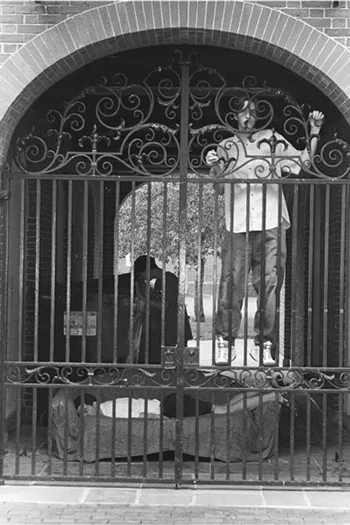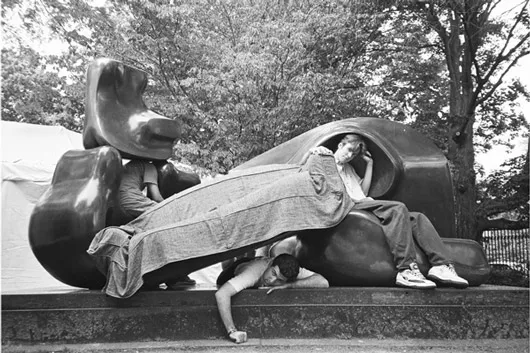During my last two years of college, I lived with two roommates, and we furnished our rooms pretty much exclusively with things we found in the trash. We were none of us poor, but we were all quite cheap, and for two years running the luck of the draw had placed us in our dormitory’s “garbage entryway,” a dingy, be-dumpstered archway where the garbage and castoffs of our entire 800-resident undergraduate house was left pending weekly pickup
The downside of this was, of course, the occasional smell and gloom brought on by the persistent shadows and the huge wrought iron gate locked every day but trash day. But the upside made it almost worth it: if anything good was being thrown out, we would know about it, and, given need and space, would give it a second chance at college life
 That was the logic of the garbage entryway. But there was, in our experience, more than a hint of providence to it as well: sitting around our empty common room, it seemed we only had to speak the name of the item we realized we needed—a phone-stand, a coffee-table, a television or two for an in-room video installation (“Watching people watching people watching TV!”)—and it would be guaranteed to show up in the garbage (and thus in our suite) within a week. So it was, one fall day, that one of us said, “You know, what we really need is a couch. How come nobody ever throws those away?” And what should appear outside our window but a torn and tattered red sofa, borne aloft across the courtyard by a trio of jock-ish pallbearers?
We cut the funeral short, but the couch really was a sad affair: flimsily crafted of foam rubber and cardboard, the upholstery fairly shredded, more a sofa-shaped object than the sofa itself. One of us said, “Are you sure we want to keep this? If only we had some sort of large cloth to drape it with.” And another said, “Hey look, there’s one of the guys who threw it out. What’s that big blue drape-y thing he’s carrying to the trash?” The slipcover, alas, had to be recovered from rather deep inside the dumpster, but once we’d managed to forget that detail, we were able to get its blue denim billows draped and tucked into a convincingly couchlike form
We named our sofa Gatsby because, like F. Scott Fitzgerald’s hero, he looked good on the outside but—and here with a flourish we’d lift the hem of Gatsby’s dress—on the inside he was all torn up. This was a less frightening explanation than the other similarity with the short-lived prince of West Egg, Long Island: if you went to Gatsby looking for anything approaching real support, the moment you relinquished your balance he’d dump you right to the floor
That was the logic of the garbage entryway. But there was, in our experience, more than a hint of providence to it as well: sitting around our empty common room, it seemed we only had to speak the name of the item we realized we needed—a phone-stand, a coffee-table, a television or two for an in-room video installation (“Watching people watching people watching TV!”)—and it would be guaranteed to show up in the garbage (and thus in our suite) within a week. So it was, one fall day, that one of us said, “You know, what we really need is a couch. How come nobody ever throws those away?” And what should appear outside our window but a torn and tattered red sofa, borne aloft across the courtyard by a trio of jock-ish pallbearers?
We cut the funeral short, but the couch really was a sad affair: flimsily crafted of foam rubber and cardboard, the upholstery fairly shredded, more a sofa-shaped object than the sofa itself. One of us said, “Are you sure we want to keep this? If only we had some sort of large cloth to drape it with.” And another said, “Hey look, there’s one of the guys who threw it out. What’s that big blue drape-y thing he’s carrying to the trash?” The slipcover, alas, had to be recovered from rather deep inside the dumpster, but once we’d managed to forget that detail, we were able to get its blue denim billows draped and tucked into a convincingly couchlike form
We named our sofa Gatsby because, like F. Scott Fitzgerald’s hero, he looked good on the outside but—and here with a flourish we’d lift the hem of Gatsby’s dress—on the inside he was all torn up. This was a less frightening explanation than the other similarity with the short-lived prince of West Egg, Long Island: if you went to Gatsby looking for anything approaching real support, the moment you relinquished your balance he’d dump you right to the floor
From that day onward we were a foursome—Doug, Jonathan, Nate, and Gatsby—and the sofa became a focal point of our common life, our common lingo, and our common plans. On the coffee table we kept a spiral notebook labelled Our Thoughts , and of an evening one or another of us would sprawl cautiously on Gatsby and add entries to the various lists we compiled therein: “Books to Read at Some Point,” “Things We’ve Learned (Not to Eat) from Experience,” “Movie Ideas,” “Food Products Whose Mascot is a Sentient, Living Version of the Product Itself,” “Band Names.” One of the longer lists (eclipsed perhaps only by “My Poet Had a Day Job!”) was a simple litany of our favourite college landmarks, under a single heading: “Project Gatsby
 The origins of our plot to carry our sofa all over our campus and photograph ourselves sitting on it are a little murky, but I think the twin inspirations must have been the tatty couch featured on The Cranberries’ album covers, and a travel book I’d heard about with the pleasing self-explanatory title, Round Ireland with a Fridge. Anyway, our senior year flew smartly by as the Project Gatsby list grew and grew: always the time to add to the itinerary, never the time to carry it out. Until, finally, the Saturday before graduation, when our last papers were in and our last finals finalized, already June yet just a week or two into the full Massachusetts spring, at last it was time, at last we were ready
We recruited our mutual friend Henry as a photographer, stuck a roll of black-and-white in Jonathan’s pocket camera, and headed out with our sofa. At last, thank goodness, Gatsby’s featherweight foam-and-cardboard carcass was an asset—once we’d made it down the four twisting flights of stairs and into the open, the going was actually quite easy. We fairly jogged, couch in arms, from spot to preordained spot: stop, drop, sit and pose, then up again and onward. It was a joyous extended moment—realizing at long last our crazy plans, laying claim to the campus that had been home for the past four years by treating it as, well, one big giant living room, a place of fun and welcome and friendship, of not-quite-stable comfort but of endless inspiration
[hang1column]
The origins of our plot to carry our sofa all over our campus and photograph ourselves sitting on it are a little murky, but I think the twin inspirations must have been the tatty couch featured on The Cranberries’ album covers, and a travel book I’d heard about with the pleasing self-explanatory title, Round Ireland with a Fridge. Anyway, our senior year flew smartly by as the Project Gatsby list grew and grew: always the time to add to the itinerary, never the time to carry it out. Until, finally, the Saturday before graduation, when our last papers were in and our last finals finalized, already June yet just a week or two into the full Massachusetts spring, at last it was time, at last we were ready
We recruited our mutual friend Henry as a photographer, stuck a roll of black-and-white in Jonathan’s pocket camera, and headed out with our sofa. At last, thank goodness, Gatsby’s featherweight foam-and-cardboard carcass was an asset—once we’d made it down the four twisting flights of stairs and into the open, the going was actually quite easy. We fairly jogged, couch in arms, from spot to preordained spot: stop, drop, sit and pose, then up again and onward. It was a joyous extended moment—realizing at long last our crazy plans, laying claim to the campus that had been home for the past four years by treating it as, well, one big giant living room, a place of fun and welcome and friendship, of not-quite-stable comfort but of endless inspiration
[hang1column] ](@assets/images/gatsby3*710.jpg)[/hang1column]
We covered a lot of ground that day, crossed off most of the spots on the list and came up with a few other poses on the fly. After that whirlwind afternoon, we schlepped the couch back up four twisting flights so we could fall, exhausted onto it, or rather, him
None of us is sure what happened to Gatsby after we moved out. I’d always thought that we’d bequeathed him to Doug’s college-bound younger brother. Doug, for his part, recalls our having sold him, along with our other college-trash freebies, for around $20, a sum that seems both unbearably low and impossibly high. Jonathan, the first of us to leave, kept the developed film, and it wasn’t till a year later that he and I were able to get together to order prints and make up little Project Gatsby photo albums for all involved, full of copied-out quotes I found flipping through the pages of _The Great Gatsby*—a book that none of us (truth be told) had looked at since high school, but whose words now rung with nostalgic couch-specific melancholy. Was it still just one big joke, the high-art riffing and literary allusions, or were we more serious than we realized at the time?
](@assets/images/gatsby3*710.jpg)[/hang1column]
We covered a lot of ground that day, crossed off most of the spots on the list and came up with a few other poses on the fly. After that whirlwind afternoon, we schlepped the couch back up four twisting flights so we could fall, exhausted onto it, or rather, him
None of us is sure what happened to Gatsby after we moved out. I’d always thought that we’d bequeathed him to Doug’s college-bound younger brother. Doug, for his part, recalls our having sold him, along with our other college-trash freebies, for around $20, a sum that seems both unbearably low and impossibly high. Jonathan, the first of us to leave, kept the developed film, and it wasn’t till a year later that he and I were able to get together to order prints and make up little Project Gatsby photo albums for all involved, full of copied-out quotes I found flipping through the pages of _The Great Gatsby*—a book that none of us (truth be told) had looked at since high school, but whose words now rung with nostalgic couch-specific melancholy. Was it still just one big joke, the high-art riffing and literary allusions, or were we more serious than we realized at the time?
Around the time of our five-year college reunion, Project Gatsby evolved once more, as I stitched together a video version, a mix of pages from the albums, random images taken from books we’d found in the trash then, books about the future, written far in the past and thus, to the couch-borne observer, wistfully hilarious. The soundtrack was an eerie mix of Philip Glass, Louie Armstrong and a Mississippi field holler; the narration was my own, or rather Fitzgerald’s, a cutely bleak little love letter to a time of grace and gifts: “So we beat on, boats against the current, borne back ceaselessly into the past